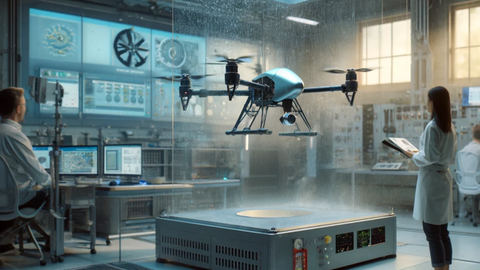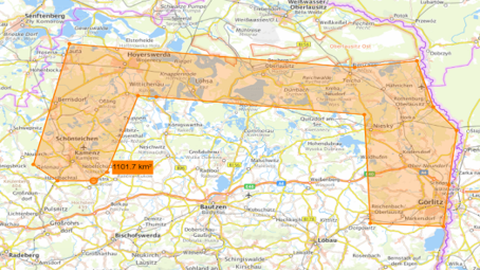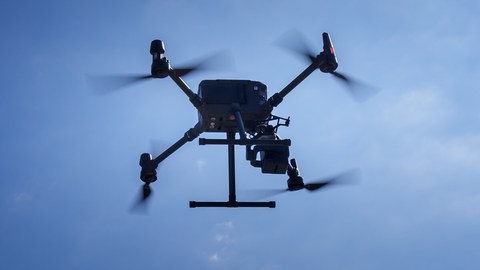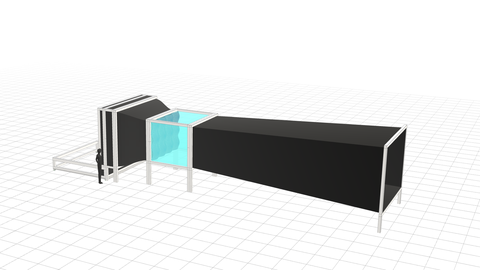Übersicht
Das Testcenter für automatisiertes Fliegen und autonome Systeme (TAFAS) am Smart Mobility Lab bietet eine europaweit einzigartige Forschungsinfrastruktur. Von der Multifunktions-Flughalle über EMV- und Klimatests bis hin zu U-Space-Integration und Vertiport entstehen hier praxisnahe Bedingungen für die sichere Erforschung und Erprobung von UAVs und eVTOLs.
Infrastrukturbereiche
TAFAS vereint unterschiedliche Testumgebungen unter einem Dach – von Indoor-Flughalle und Klimaraum über EMV-Absorberraum bis hin zu Außentestgelände und Vertiport. Diese Infrastruktur bildet die Grundlage für praxisnahe Experimente, Validierungen und Zulassungsnachweise für UAVs und eVTOLs.
Infrastrukturbereiche
Multifunktionale Testhalle
Die Flughalle (100 × 100 × 35 m) bietet Testvolumen für UAVs bis 19 m Spannweite. Ein Indoor-Lokalisierungssystem ermöglicht exakte 3D-Flugbahnen, ergänzt durch einen digitalen Zwilling und modulare Hindernisparcours für Pfadplanung oder Conflict Detection. Ein mobiler Windshaper simuliert Windfelder, Sicherheitsfeatures wie Bodenfesseln sorgen für verlässliche Tests.
EMV-Absorberraum
Der EMV-Absorberraum (20 × 20 × 8 m) ermöglicht sichere Tests zur elektromagnetischen Verträglichkeit von UAVs und eVTOLs. Kommunikationssysteme in UHF/VHF/HF können geprüft werden, ebenso Jamming- und Spoofing-Szenarien für Recovery-Algorithmen. Auch C2-Systeme lassen sich auf Redundanz und Notfallreaktionen validieren.
Wind- & Wettertests
Der Wetter- und Klimaraum (20 × 20 × 10 m) simuliert realistische bis extreme Umweltbedingungen. Mit Windshaper, Messtechnik und Windkanalvorbau lassen sich Strömungen, urbane Windfelder und Infrastruktureffekte präzise untersuchen. Ergänzend erzeugt die Anlage Regen, Nebel und Lichteffekte – ideal für Sensorik-, Performance- und Sicherheitsnachweise.
Außenfläche mit Vertiport
Das Außentestgelände (400 × 200 m) bietet eine praxisnahe Ergänzung zu den Indoor-Tests. Ein befeuerter Vertiport erlaubt realistische Start- und Landeverfahren, ergänzt durch Bodenfesseln für sichere Testkonfigurationen. Dank 5G/6G-Konnektivität lassen sich komplexe Szenarien zuverlässig durchführen und Performance- wie Sicherheitsnachweise unter realen Bedingungen erbringen.
BVLOS-Testgebiet
Das Beyond Visual Line of Sight (BVLOS)-Testgebiet „U-Space Lausitz“ (aktuell ~1.100 km²) bietet einzigartige Bedingungen für autonom geführte Systeme. Hier werden Betriebskonzepte, Sicherheitsverfahren und neue Dienste für UAVs >25 kg MTOW praxisnah erprobt. Mit LBA-Zulassung, 3D-Infrastruktur und langen Teststrecken entsteht bis 2026 der größte BVLOS-Raum Europas (>2.000 km²).
Forschung
Urbane und regionale Mobilität neu denken: Interdisziplinäre Forschung zu Rahmenbedingungen und Anforderungen einer gesellschaftlich akzeptablen Advanced-Air-Mobility-Implementierung
Ab 01. Mai 2024 werden für reale Verkehrsszenarien dieser Art die wissenschaftlichen Grundlagen an der TU Dresden (TUD) gelegt. Das neue Graduiertenkolleg (GRK) an der TU Dresden zur „Technisch-betrieblichen Integration hochautomatisierter Luftfahrt in Ballungszentren“ (GRK 2947) setzt an der sogenannten „Advanced Air Mobility“ (AAM) und ihren notwendigen technischen wie auch gesellschaftlichen Rahmenbedingungen an.
News
Box zu AirMetro News einfügen
Equipment & Hardware
Neben den Großinfrastrukturen verfügt TAFAS über umfangreiche Forschungsgeräte und modulare Testsysteme. Dazu zählen UAV-Plattformen, Sensorik, Recheneinheiten, U-Space-Management-Technik sowie spezialisierte Strömungs- und Hindernisinfrastruktur für flexible Szenarien.
Hardware & Tools (Auswahl)
Multicopter-Plattformen
Wir verfügen über verschiedene Multicopter für Forschung und Entwicklung: DJI M3 E (RGB-Kamera), M3 T (Thermal), Avata 2 (FPV), Hexacopter PM X6 und Holybro X650. Sie dienen zur Erprobung von Flugsteuerungen, Sensorintegration und Missionsszenarien.
Onboard-Computing
Für autonome Funktionen und Datenfusion stehen leistungsfähige Recheneinheiten bereit: u. a. Jetson Orin NX, Raspberry Pi 4, ASUS NUC sowie Pixhawk-Flugsteuerungen. Damit lassen sich Algorithmen entwickeln, Sensoren anbinden und Flugmanöver in Echtzeit verarbeiten.
Sensoren
Unser Sensorpool umfasst LiDAR, RGB- und Tiefenkameras, High-Performance-Industriekameras sowie Zusatzgeräte wie Suchscheinwerfer. Diese Ausrüstung erlaubt Navigation, Umweltwahrnehmung, 3D-Rekonstruktion und die Entwicklung neuer Detektionsverfahren.
U-Space-Management
Zur Erfassung und Integration von Luftverkehr nutzen wir Aerobits-Tracker, Remote ID- und FLARM-Systeme sowie eigene Empfangsstationen für Remote ID, FLARM und ADS-B. Damit lassen sich U-Space-Operationen, Kollisionsvermeidung und die Interaktion mit UAVs in komplexem Luftraum realitätsnah untersuchen.
Wind- & Strömungstechnik
Für realistische Strömungstests stehen ein 3x3 m Windshaper, Windkanalvorbau und ein Drehteller zur Verfügung. Präzise Messsysteme wie Hitzedrahtsonden und Drucksensoren erlauben die detaillierte Analyse von Windfeldern und deren Wirkung auf UAVs – von Stabilitätstests bis zu urbanen Szenarien.
Modulare Hindernisse
Zur Nachbildung komplexer Umgebungen nutzen wir aufblasbare und modulare Hindernisse sowie bedruckte Planen, die von der Decke abgehängt werden. Damit lassen sich urbane Strukturen, Straßenschluchten oder Verkehrsflächen realistisch simulieren und Szenarien für Conflict Detection & Resolution abbilden.
Ansprechpartner TAFAS
 © Sven Ellger
© Sven Ellger











